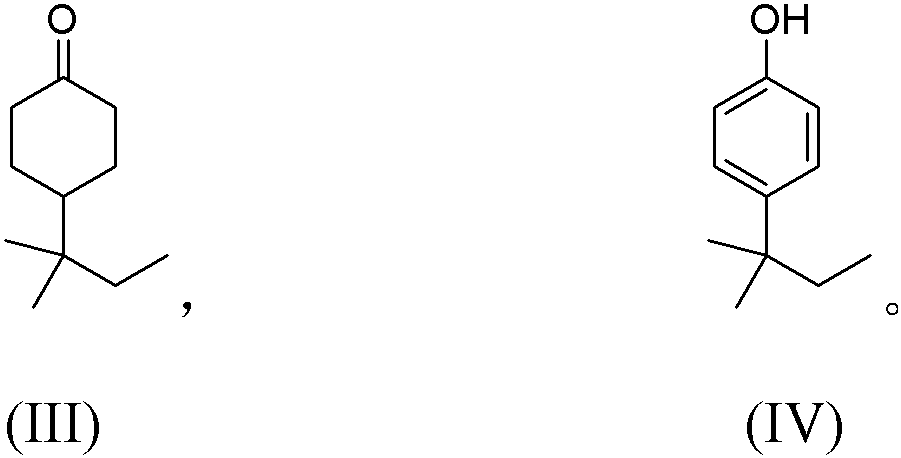Methods of preparing cyclohexanone and derivatives
A technology for cyclohexanone and oxides, which is applied in the field of preparing cyclohexanone and its derivatives, and can solve problems such as increased energy consumption and environmental problems
- Summary
- Abstract
- Description
- Claims
- Application Information
AI Technical Summary
Problems solved by technology
Method used
Image
Examples
Embodiment 1
[0050] Embodiment 1. Catalyst separation
[0051] Pd-γ-Al 2 o 3 Preparation: 0.143g of palladium acetylacetonate (Pd(acac) 2 ) was dissolved in 25mL of acetone, and the solution was impregnated into 1g of γ-Al at 40°C 2 o 3 . The resulting Pd-γ-Al 2 o 3 Contains 5% by weight of Pd. After impregnation, the catalyst was dried at 100°C for 2 hours and calcined in a muffle furnace at 450°C for 2 hours at a heating rate of 3.5°C / min.
[0052] Catalyst 1 : Dissolve 5 mL of 5.8 mg of Na by immersion at 80 °C 2 CO 3 The aqueous solution was introduced to 0.5 g of the catalyst Pd-γ-Al prepared above 2 o 3 . After drying the catalyst at 100 °C for 2 h, it was 2 Reduction was carried out at 150° C. for 2 hours under flow, thereby obtaining Catalyst 1 with 0.5% by weight Na.
[0053] Catalyst 2 : Dissolve 5 mL of 11.6 mg of Na by impregnation at 80°C 2 CO 3 The aqueous solution was introduced to 0.5 g of the catalyst Pd-γ-Al prepared above 2 o 3 . After drying the ca...
Embodiment 2
[0058] Example 2. Hydrogenation of p-tert-amylphenol using catalysts 1-6
[0059] The hydrogenation reaction was carried out in a strengthened glass reactor equipped with a pressure gauge to monitor the pressure in the reactor. 10.5 mg of one of the catalysts and 495 mg of p-tert-amylphenol were added to the reactor. The reactor is then purged with hydrogen, pressurized to 5 bar (dynamic pressure) with hydrogen, heated to 100° C., and maintained at this temperature for a period of time (eg, 10 to 16 hours). Quantitative analysis of the reaction mixture after filtration was carried out in GC-MS and GC-FID. Conversion was calculated as moles of p-tert-amylphenol converted / initial moles of the compound x 100%. The yield of the desired product Orivone or the by-product 4-tert-amylcyclohexanol was determined as the number of moles of the compound / the initial number of moles of p-tert-amylphenol×100%. The Orivone selectivity was calculated as the number of moles of Orivone / the nu...
Embodiment 3
[0063] Example 3. Utilization of Catalyst 2 (on γ-Al 2 o 3 5% Pd and 1% Na) hydrogenation of p-tert-amylphenol
[0064] The hydrogenation reaction is carried out in a reinforced glass reactor equipped with a pressure gauge. 10.5 mg of catalyst, 495 mg of p-tert-amylphenol and 500 mg of solvent (water or tetrahydrofuran (THF)) were introduced into the reactor, which was purged with hydrogen and pressurized with hydrogen at 5 bar (dynamic pressure), and finally The reactor was heated at 100°C. Quantitative analysis of the reaction mixture after filtration was carried out in GC-MS and GC-FID. Table 2 below lists the results obtained with Catalyst 2 carried out in the absence of solvent and compared with the case of using THF and water as solvent.
[0065] Table 2
[0066] solvent
PUM
 Login to View More
Login to View More Abstract
Description
Claims
Application Information
 Login to View More
Login to View More - R&D
- Intellectual Property
- Life Sciences
- Materials
- Tech Scout
- Unparalleled Data Quality
- Higher Quality Content
- 60% Fewer Hallucinations
Browse by: Latest US Patents, China's latest patents, Technical Efficacy Thesaurus, Application Domain, Technology Topic, Popular Technical Reports.
© 2025 PatSnap. All rights reserved.Legal|Privacy policy|Modern Slavery Act Transparency Statement|Sitemap|About US| Contact US: help@patsnap.com


